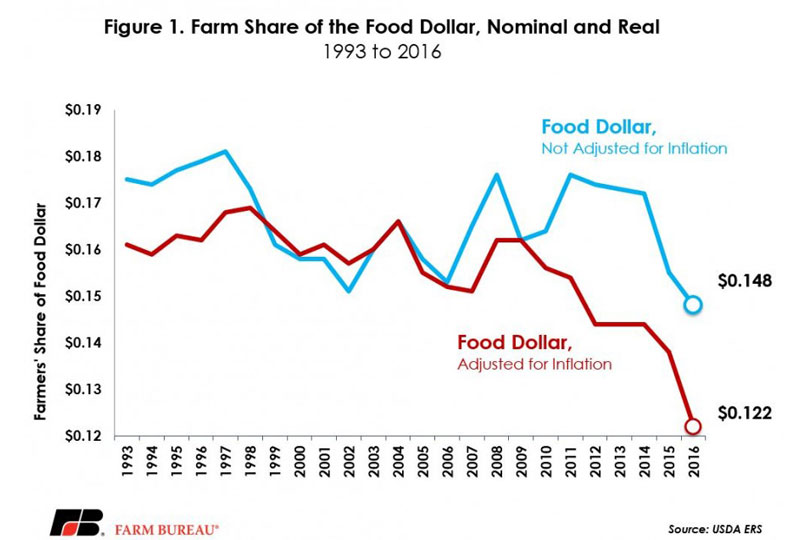By Jessica Domel
Multimedia Reporter
A new study reveals American farmers now earn less than 15 cents of each food dollar spent. At 14.8 cents, the farmers’ share is now at the lowest level since the U.S. Department of Agriculture Economic Research Service launched its Food Dollar Series in 1993.
“There are a variety of factors that are playing into the lower share of the food dollar, one of which is the lower commodity prices. Farmers and ranchers have seen their prices fall quite a bit in recent years,” Dr. John Newton, director of Market Intelligence for the American Farm Bureau Federation (AFBF), said. “Another factor worth noting is the increased share of processing and marketing costs in that food dollar now at more than 85 percent.”
The largest factor, according to Newton, is part of a larger trend.
“More and more consumers are consuming their food outside of the home, and the farmers’ share of the food dollar away from home is less than a nickel,” Newton said. “As more consumers consume their food away from home, the lower proportion of the food dollar starts to mean more and more into the overall share. It pulls it down.”
A lower farmers’ share, combined with net farm income at a 12-year-low, continues to confirm how difficult it is for the nation’s farm and ranch families right now.
“It really highlights how important it is to get a farm safety net done on time—i.e. the 2018 Farm Bill. It reiterates how challenging of an economic environment it is for farmers and ranchers,” Newton said.
The farmers’ share of the food dollar for food and beverages consumed at home is around 23 cents. That’s down 3.8 percent from 2015.
Increased costs for food service and preparation pushed the farmers’ share of food and drinks consumed away from home to four cents in 2016.
That’s down 10.2 percent over 2015.
“If consumers wanted to do something that would put a little bit more money in the farmers’ pocket, that would be eating more at home,” Newton said. “The farmer does have a greater share of that food dollar.”
Newton said he has not seen an overall trend in one way or another regarding the farmers’ share.
“It does move around. As commodity prices change, the farmers’ share of that food dollar is going to change. If we see changes in consumption—consumers spending a little more time at home—that can change this value,” Newton. “It does fluctuate through time. I don’t think we’re seeing an overall declining trend. It’s certainly an opportunity for it to improve in upcoming years. Note that this data is 2016 data. We don’t yet know what it was for 2017.”
According to AFBF, the farmers’ share of the food dollar represents the percentage of the food commodity sales tied to a food dollar expenditure.


This kind of information tracking may be meaningful to somebody, but I think it sheds little light on the fact that the producer (farmer, rancher) is not being paid a fair price for his production of food. At 23% of the food dollar for the producer, there is $3.35 paid to the packagers, shippers, distributors, retailers, etc. for the food prepared at home. At 5% of the food dollar for the producer, there is $19 paid to the shippers, distributors, wholesalers, and restaurants (managment, chefs, tablecloths, servers, entertainment, etc.) for the food eaten out. Some restaurants charge widely varying prices for food for which the ingredient costs are the same. People eating at home more often will change your percentages, but will it actually put more money in the producer’s pocket? People need to be willing to pay what it costs for quality food. Food is not a discretionery expense. When did we start believing that the essentials should be low cost in order that we have more money to spend on non-essentials?